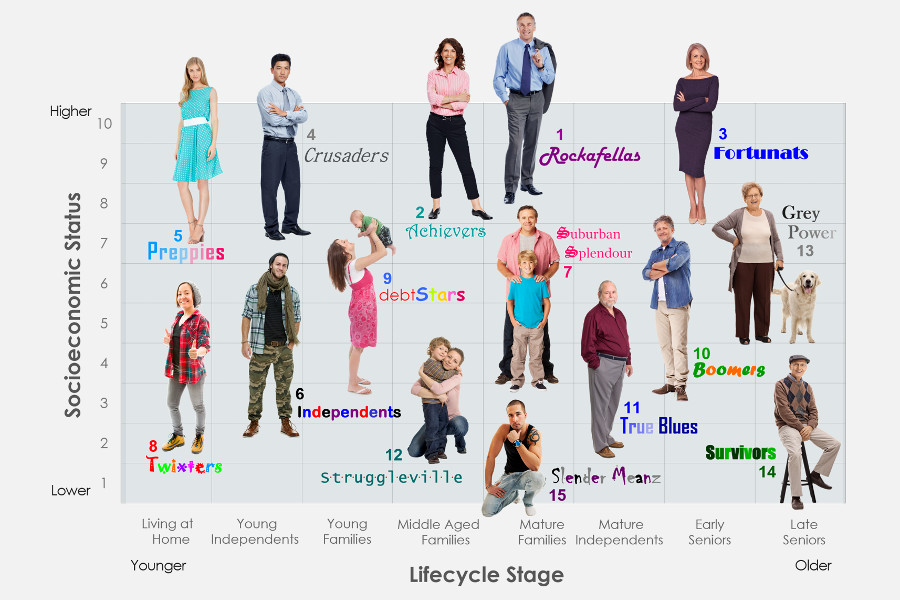The geoTribes segmentation scheme has 15 person-level segments, each with a unique needs profile based on lifecycle stage and socioeconomic status. With extensive applications across database analysis, media planning, retail analytics and customer engagement, geoTribes has proven itself to be both powerful and readily utilised. This power comes at two levels: Psychological and Geographic.
Firstly, at the Psychological level, geoTribes taps into the concept of tribal affiliation. A tribe can be defined as a group of people who share common needs and values. On a broader level, tribes share a collective identity, reflected in common attitudes & behaviours – likes, dislikes, aspirational figures, trendy products, must haves, favourite places and a similar disposition towards others. These reflections add up to a whole identity. In the search of an ideal image, people are often compelled to purchase ‘must have’ objects which signify membership of their particular tribe.
In this way, collective tribal identity can be interpreted as an archetype, a primal form or ‘perfect example’ of a particular tribe. Such archetypes are represented in the geoTribes segmentation scheme by thumbnail sketches. Within any particular product or service category, a tribe trends towards a collective need state. This need state is a complex web of rational, emotional, environmental and personal triggers that lead to a particular brand, product, service choice or behavioural outcome within a given category.
The need state for a particular tribe thus acts as a common basis for communication between the customer as a tribe member on one hand and a corporate brand that is selling to the tribe on the other.
On the customer side, the language is in terms of needs, values and benefits sought. On the corporate brand side, the language is in terms of brand values, product features, customer relationships and purchase triggers.
For a meaningful interaction to occur, it is necessary for the customer’s needs, values and benefits sought to align with the brand values and proposition features of the corporate brand. For example, in the category of motor vehicles, the Rockafella’s need for status, quality and recognition is met by the brand attributes of the Mercedes ‘E’ and ‘S’ class vehicles or BMW ‘5’ series.
The second level driving geoTribes’ power as a segmentation scheme is Geographical.
One of the prime ways in which people manifest their tribal identity is through choosing a place to live. Beside the practicalities of finding a place suitable for their lifecycle stage (a flat to live in pre and post family or a house of appropriate size to reflect family needs) another key factor is the choice of an address with the ‘right’ Socioeconomic status (SES).
SES varies considerably across a large city like Sydney, with areas of similar SES tending to be pocketed across the city as seen below:

When the effects of SES and lifecycle stage are taken conjointly, geoTribes segments are seen to be concentrated in particular areas. For example, the concentration of Rockafellas is derived from concentrations of middle-aged family householders with a high SES rank. Hence, the geographic concentration of tribes reflects the maxim that ‘birds of a feather flock together’. This of course is an aspect of all geodemographic systems.
The real power of the geoTribes comes from the incorporation of factual age in the fitment process. This means that within a given street and even within a household, the substantial differences in tribal identity between lifecycle stages are faithfully reflected in the scheme on a person by person basis.
For more information on geoTribes Segments visit the product page on the RDA research website or contact us at the help desk by calling +612 8923 6600.
